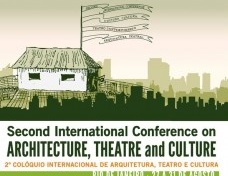
newspaper
eventos
The main focus of the Second International Conference on Architecture, Theatre and Culture is to discuss the dramaturgy and architecture during the 17th century and the theatrical spaces of the period in London, Madrid, Paris and Lisbon.
Written and iconographic documentation now allows researchers to re-envision the theatrical architecture of the time with new references to the urban land use in the four capitals.
Recent academic work in European concerning theatre architecture of the early modern period (1580-1680) – especially in England, Spain and France – has given new meaning and suggests new possibilities to staging in spaces built or restructured to receive large numbers of people.
The great playwrights of the 17th century absorbed the dialectic between the theatre and its space, developing distinct forms in each of these three European nations.
Alongside presentations specifically relating to the 17th century, communications will be accepted on the three focal points of the Conference (Theatre architecture, Theatre and Cultural History), in accordance with the criteria of the Scientific Committee.
Call for papers
The Second International Conference on Architecture, Theatre and Culture is accepting abstracts to present papers on the three themes. The abstracts shall be of less than 500 words, will be written in English- Portuguese, or in Spanish – English or French – English and must be theoretical or narrating a study case. The abstract shall be send to email.
Further details in the website.
Submission deadlines
Abstract submission: until 20 March 2012
Report on the results: 31 April 2012
Submission of full papers: July 20, 2012
Opening event: August 27, 2012
Themes and topics
Theme I – Theatre architecture from the 17th century to contemporary
- Relationships between buildings and city
- Real Space x Imaginary Space
- Stage design and architecture
- ”Found” Space inside or outside buildings
- Architectures adapted for theatre
- Theatre Architecture and new technologies
- Theatre Architectural Heritage
Theme II – Theatre: from the 17th century to contemporary
- Reflections on 17th century playwriting
- Modern and contemporary adaptations from 17th century authors
- Research on History of Theatre
- The cultural heritage of the theatre
- Writing of theatre history between text and images
- Relationships between the 17th century theatre and the 20th century theatre
Theme III – Culture: cultural history from 17th century to contemporary
- Genres of the 17th century and its impact on the theatre of the 20th century
- Cultural Indicators and the interpretation of history
- Culture and history
- Puppet Theatre since the 17th century
- Culture in less developed areas
- Literate Culture x Illiterate Culture


